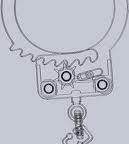 Handcuffs Handcuffs |
|
| A 101 guide on how to bind yourself and survive | |
Handcuffs are metal restraint devices designed to secure an individual's wrists close together. They comprise two parts, linked together by a chain, a hinge or in the case of rigid cuffs, a bar. Each half has a rotating arm which engages with a ratchet that prevents it from being opened once closed around a person's wrist. A ratchet consists of a linear rack with teeth, and a pivoting, springloaded finger called a pawl (or click) that engages the teeth. |
 |
Handcuffs with double locks have a lock-spring which when engaged stops the cuff from ratcheting tighter to prevent the wearer from tightening them. Tightening could be intentional or by struggling, when tightened the handcuffs may cause nerve damage or loss of circulation. Double locks also make picking the locks more difficult. Without the key, the handcuffs cannot be unlocked (see below) and so the restrained person is unable to move their wrists more than a few centimetres/inches apart, making many tasks difficult or impossible. Look around at the different types of cuffs available, there are some really comfortable ones out there for longer term bondage. |
|
| Types | |
There are two distinct sub-types of contemporary metal handcuffs: one in which the cuffs are held together by a short chain, and another, of more recent origin, which uses a hinge for this purpose. Since hinged handcuffs permit less movement than a chain cuff, they are generally considered as more secure. A third type, the rigid handcuff, has a metal block or bar between the cuffs. Handcuffs may be manufactured from various metals, including carbon steel, stainless steel and aluminium, or from synthetic polymers. Double locks There exist three kinds of double locks:
|
|
| Keys | |
| Most modern handcuffs in the United States, Canada, the United Kingdom and Latin America can be opened with the same standard universal handcuff key. This allows for easier transport of prisoners and keeps one out of trouble if one loses one's keys. However, there are handcuff makers who use keys based on different standards. Maximum security handcuffs require special keys. | |
| Useage | |
Handcuffs are for hands, well wrists actually and leg-irons or leg-cuffs are for ankle restraint, don't try to force a pair of handcuffs on to your ankles, they don't fit or if they do they may not open again.
|
|
| Basic Safety | |
|
|
| Getting Out or Escaping | |
Since handcuffs are only intended as temporary restraints, they are not the most complicated of locks. This is why escaping from handcuffs is a common stunt performed by magicians or skilled criminals. The most common methods are:
It is also technically possible to break free from handcuffs by applying massive amounts of force from one's arms to cause the device to split open or loosen enough to squeeze one's hands through; however this takes exceptional strength (and loads of spinach Popeye!) |
|
| See Also | |
| references | |